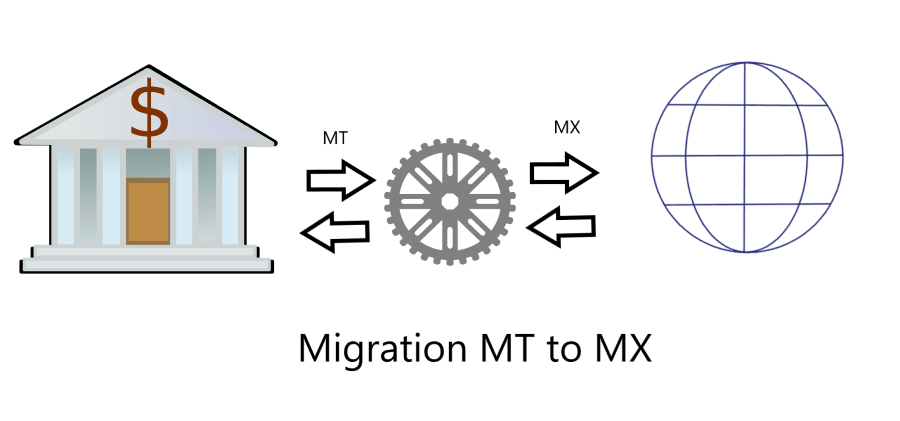In the world of international banking and financial messaging, the migration from MT (Message Type) to pacs.08 MX (XML-based messages) is a significant shift. This transition is driven by the need for greater standardization, interoperability, and efficiency in global financial communication. One of the most critical messages in this migration is the MT103, which is used for single customer credit transfers. In this blog post, we’ll explore the ISO standards, the need for MX when MT was already in place, and provide a detailed mapping of MT103 tags to their MX equivalents. We’ll also walk through a real-life example to make this transition easier to understand.
Table of Contents

What Are ISO Standards?
ISO (International Organization for Standardization) standards are globally recognized frameworks that ensure consistency, quality, and interoperability across industries. In the financial messaging world, ISO standards define the structure, format, and rules for exchanging messages between financial institutions.
- ISO 15022 (MT Messages): The older standard, based on SWIFT’s MT message format, uses a fixed-length, tag-based structure. It has been the backbone of financial messaging for decades.
- ISO 20022 (MX Messages): The newer standard, based on XML, is more flexible, extensible, and capable of carrying richer data. It is designed to meet the evolving needs of the financial industry.
Why Was MX Needed When MT Was Already There?
While MT messages have served the financial industry well, they have limitations that became apparent as the industry evolved:
- Limited Data Capacity: MT messages have a fixed structure, which restricts the amount of data that can be included. This became a problem as regulatory requirements and customer demands for richer data increased.
- Lack of Flexibility: MT messages are not easily extensible. Adding new fields or adapting to new use cases is challenging.
- Interoperability Issues: MT messages are primarily used within the SWIFT network, making it difficult to integrate with other systems or networks.
- Regulatory Compliance: New regulations, such as anti-money laundering (AML) and know-your-customer (KYC), require more detailed information than MT messages can provide.
ISO 20022 (MX) addresses these limitations by offering:
- A flexible, XML-based format.
- Support for richer data and more detailed information.
- Better interoperability across different systems and networks.
- Future-proofing through extensibility.
In this article we will discuss about MT103 to pacs.008 conversion.
MT103 to pacs.008 MX Migration: Mapping of Tags (MT to MX Migration)
The MT103 message is used for single customer credit transfers. Its MX equivalent is the pacs.008.001.xx message under ISO 20022. Below is a detailed mapping of MT103 tags to their corresponding MX elements:
| MT103 Tag | Description | MX Element (pacs.008.001.xx) | Comments |
|---|---|---|---|
| 20 | Sender’s Reference | GrpHdr/MsgId | Unique identifier for the message. |
| 23B | Bank Operation Code | CdtTrfTxInf/PmtTpInf/LclInstrm/Prtry | Specifies the type of transaction. |
| 32A | Value Date/Currency/Amount | CdtTrfTxInf/Amt/InstdAmt | Amount and currency of the transaction. |
| 50a | Ordering Customer | CdtTrfTxInf/Dbtr | Details of the sender (customer initiating the payment). |
| 52a | Ordering Institution | CdtTrfTxInf/DbtrAgt | Sender’s bank or financial institution. |
| 56a | Intermediary Institution | CdtTrfTxInf/IntrmyAgt1 | Intermediary bank involved in the transaction. |
| 57a | Account With Institution | CdtTrfTxInf/CdtrAgt | Beneficiary’s bank or financial institution. |
| 59a | Beneficiary Customer | CdtTrfTxInf/Cdtr | Details of the recipient (beneficiary). |
| 70 | Remittance Information | CdtTrfTxInf/RmtInf/Ustrd | Unstructured remittance information. |
| 71A | Details of Charges | CdtTrfTxInf/ChrgBr | Specifies who bears the charges (e.g., BEN, SHA, OUR). |
| 72 | Sender to Receiver Information | CdtTrfTxInf/RmtInf/Ustrd | Additional information for the receiver. |
You can find complete tag details here on SWIFT official website.
Real-Life Example: MT103 to pacs.008 MX Conversion
Let’s take a real-life example of an MT103 message and convert it to its MX equivalent.
MT103 Message:
:20:REF123456
:23B:CRED
:32A:231015USD100000,
:50K:/123456789
John Doe
123 Main St
New York, USA
:52A:BOFAUS3N
:57A:CITIUS33
:59:/987654321
Jane Smith
456 Elm St
London, UK
:70:Invoice 1234
:71A:SHA
:72:/INS/CITIUS33MX (pacs.008.001.xx) Equivalent:
<Document xmlns="urn:iso:std:iso:20022:tech:xsd:pacs.008.001.xx">
<CdtTrfTxInf>
<PmtId>
<MsgId>REF123456</MsgId>
</PmtId>
<PmtTpInf>
<LclInstrm>
<Prtry>CRED</Prtry>
</LclInstrm>
</PmtTpInf>
<Amt>
<InstdAmt Ccy="USD">100000</InstdAmt>
</Amt>
<Dbtr>
<Nm>John Doe</Nm>
<PstlAdr>
<StrtNm>123 Main St</StrtNm>
<TwnNm>New York</TwnNm>
<Ctry>US</Ctry>
</PstlAdr>
<Id>
<OrgId>
<Othr>
<Id>123456789</Id>
</Othr>
</OrgId>
</Id>
</Dbtr>
<DbtrAgt>
<FinInstnId>
<BIC>BOFAUS3N</BIC>
</FinInstnId>
</DbtrAgt>
<CdtrAgt>
<FinInstnId>
<BIC>CITIUS33</BIC>
</FinInstnId>
</CdtrAgt>
<Cdtr>
<Nm>Jane Smith</Nm>
<PstlAdr>
<StrtNm>456 Elm St</StrtNm>
<TwnNm>London</TwnNm>
<Ctry>GB</Ctry>
</PstlAdr>
<Id>
<OrgId>
<Othr>
<Id>987654321</Id>
</Othr>
</OrgId>
</Id>
</Cdtr>
<RmtInf>
<Ustrd>Invoice 1234</Ustrd>
</RmtInf>
<ChrgBr>SHA</ChrgBr>
</CdtTrfTxInf>
</Document>Benefits of MX Over MT
- Richer Data: MX messages can carry more detailed information, making them ideal for regulatory compliance and customer needs.
- Flexibility: The XML-based format allows for easy extension and adaptation to new use cases.
- Interoperability: MX messages can be used across different networks and systems, not just SWIFT.
- Future-Proofing: ISO 20022 is designed to evolve with the industry, ensuring long-term relevance.
Conclusion
The migration from MT to MX is a critical step for financial institutions looking to stay competitive and compliant in a rapidly evolving industry. By understanding the ISO standards, the need for MX, and the detailed mapping of MT103 tags to MX elements, you can ensure a smooth transition. The real-life example provided above demonstrates how an MT103 message can be converted into its MX equivalent, highlighting the flexibility and richness of the ISO 20022 format.
If you’re planning an MT to MX migration, start by analyzing your current MT messages, mapping them to MX equivalents, and testing the new format in a controlled environment. With the right approach, this migration can unlock new opportunities for your organization.
We will be discussing about Cover messages in next article. And equivalent MX.
thanks for sharing this material which is quite difficult to find around the web. I find this very relevant for the banking industry and the newer format indeed has many advantages over the previous MT format.